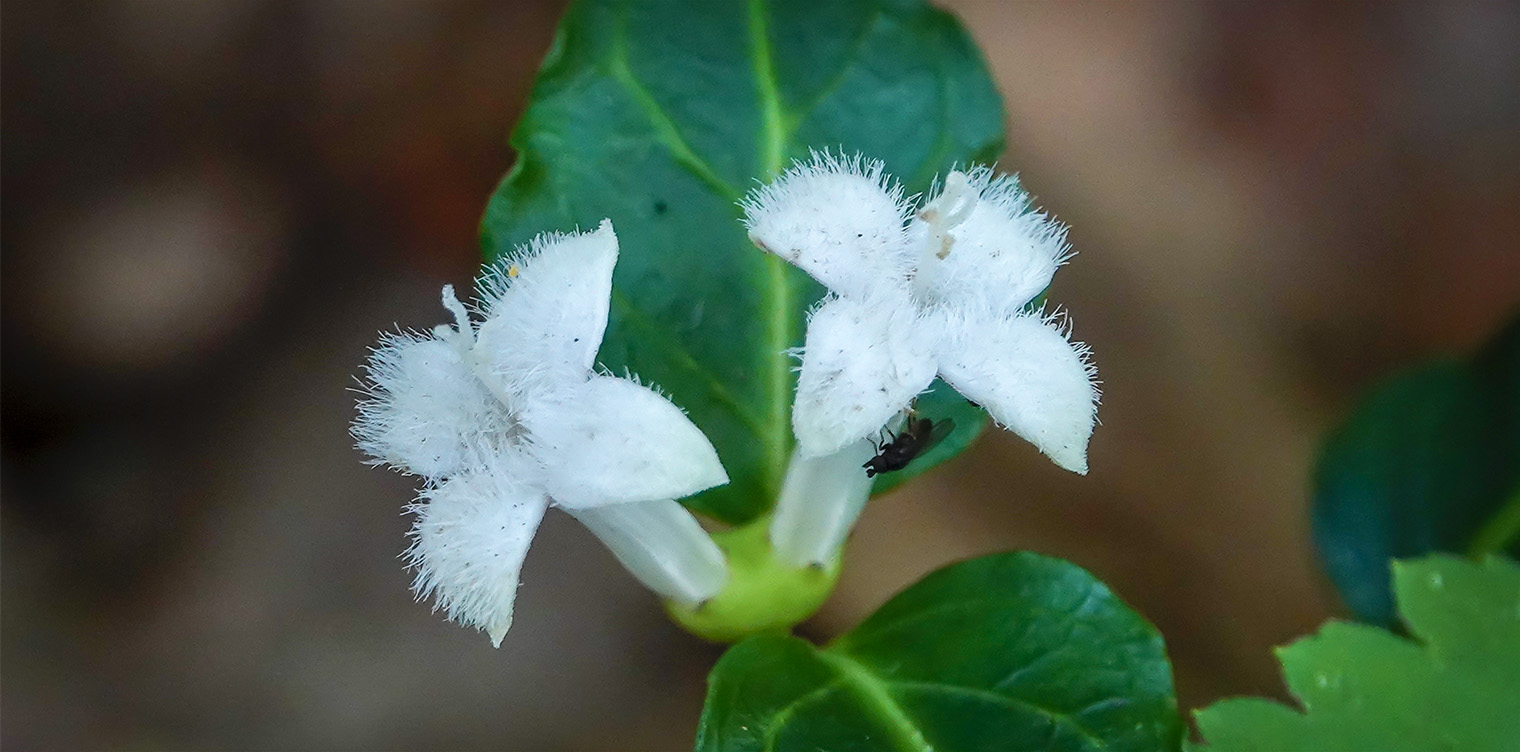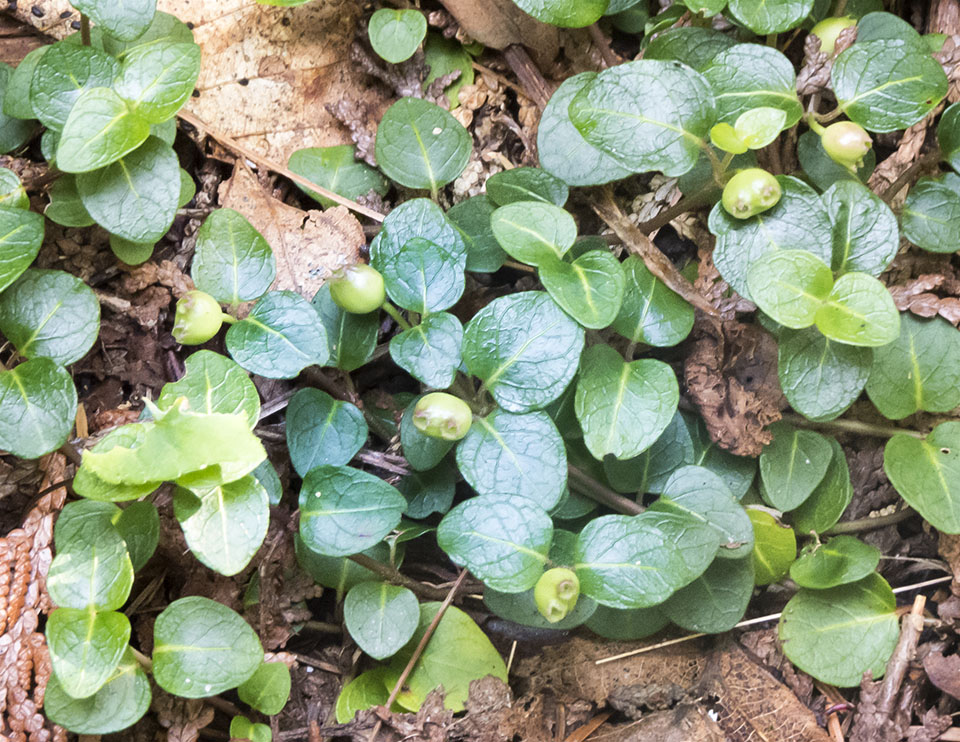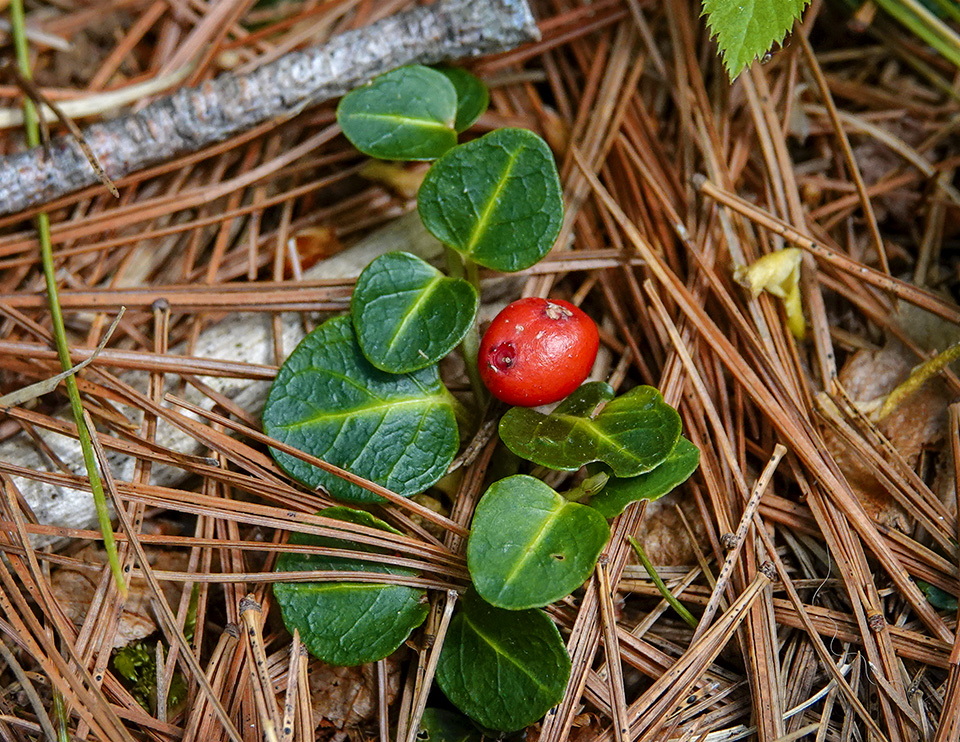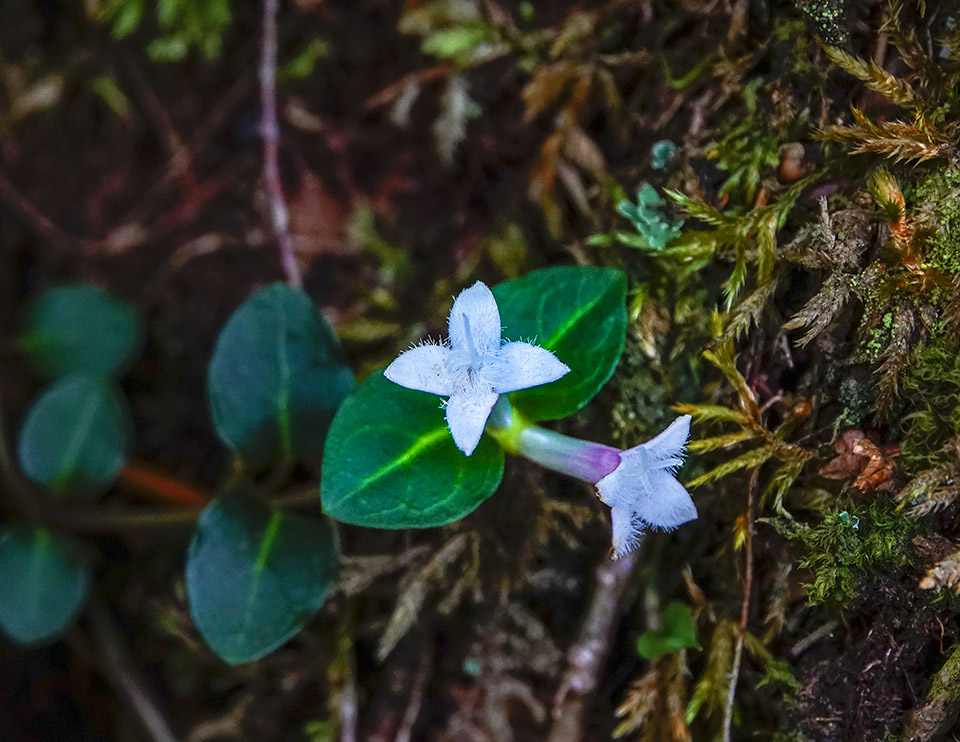Wildflowers of the Adirondacks:
Partridgeberry (Mitchella repens)

Partridgeberry (Mitchella repens) is a trailing, evergreen plant which produces small, fuzzy white flowers in late June and July in the Adirondack Mountains of upstate New York. It is a member of the Madder Family (Rubiaceae).
The common name (Partridgeberry) is apparently a reference to the belief that the berries are relished by partridges. Partridgeberry is also known as Twinberry, Deer Berry, and Squaw Berry. The genus name (Mitchella) is for John Mitchell, a Virginian physician and botanist who corresponded with Linnaeus. The species name (repens) refers to the plant's creeping habit.
Identification of Partridgeberry

Partridgeberry is an evergreen plant, about two inches high, which often forms a loose mat of slender, trailing stems that sprawl on the forest floor. Where the nodes come into contact with the forest floor, the stems take root and may spread into colonies several yards across.
The evergreen leaves are dark green and rather glossy. The leaves are round to oval and opposite, meaning that the leaves emerge from the stem in opposing pair. The leaves are smooth along the edges and about ½ inch across, with a short stalk and a prominent, whitish-green center stripe.
Partridgeberry flowers are tiny, white, and fragrant. They are preceded by small, deep pink buds. The flowers usually grow in terminal pairs, up to ½ inch long, with four petal-like lobes. The inner surfaces are covered with a dense white hairs, giving the flowers a fuzzy appearance.
Partridgeberry usually starts blooming in the Adirondack Mountains in early summer. A tally of flowering dates for the upland Adirondack areas compiled by Michael Kudish, based on data collected from the early seventies to the early nineties, lists the flowering date as 15 July. In recent years, Partridgeberry has started to bloom in very late June or early July, with the buds appearing a week or two earlier.

The flowers are followed by fruit in the form of a berry-like drupe containing eight seeds. Both flowers must be pollinated to produce a single berry, about ¼ to ½ inch in diameter. The berries, which are initially green, gradually ripen in fall to a bright scarlet. Because each berry is the result of the fusion of each ovary of the pollinated pair of white flowers, the berry has two bright red "eyes" on its surface. Unless eaten by wildlife, the berries generally survive through winter and into the following spring.
Partridgeberry's bright red berries are about the same size and color as those of Wintergreen, another low-growing evergreen plant found in the Adirondacks. In both cases, the berries persist through the winter. The leaves, however, are very different.
- Wintergreen's leathery leaves are alternate, meaning that there is one leaf per node along the stem, in contrast to Partridgeberry's opposite leaves.
- Wintergreen leaves are elliptical and somewhat larger than those of Partridgeberry.
- In addition, Wintergreen's leaves lack the prominent whitish-yellow center vein of Partridgeberry.
Uses of Partridgeberry
The berries of this species reportedly are edible, but are said to be nearly tasteless. Tea made from Partridgeberry leaves was used by several native American groups as an aid in childbirth. The plant was also used to treat medical ailments, such as insomnia, fever, rheumatic pain, and back pain. For instance, the Abnaki applied it externally for swellings. The Cherokee used a decoction made with milk for dysentery. The Delaware used an infusion of roots or twigs as herbal steam for rheumatism. The Iroquois used a compound infusion of roots and bark for back pain.
Wildlife Value of Partridgeberry

Partridgeberry is of marginal importance to wildlife. The fruit of Partridgeberry is eaten by a number of game birds and some mammals. Species which are said to consume the fruit of Partridgeberry include the Ruffed Grouse, Wild Turkey, Red Fox, Raccoon, White-tailed Deer, Red Squirrel, and White-footed Mouse. However, in all cases, the berries make up a very small percentage of the diet.
Distribution of Partridgeberry
Partridgeberry is widely distributed throughout the eastern United States, ranging from Newfoundland south to central Florida and from southern Ontario and Minnesota south to eastern Texas. Partridgeberry is listed as threatened in Iowa.
This plant is found in most counties in New York State. Its presence has been confirmed in all counties of the Adirondack Park Blue line, with the exception of Clinton and Herkimer counties.
Habitat of Partridgeberry
Partridgeberry is shade-tolerant and prefers well-drained soil. It can grow in both dappled sunlight and complete shade, under hardwoods, pines, or hemlocks. In the Adirondack Mountains, Partridgeberry is found in both northern hardwood and mixed wood forests, in several ecological communities:
Look for Partridgeberry along many of the trails covered here, including the Lakeshore Trail at the Peninsula Nature Trails, the Rock Garden Trail at Heart Lake, and along the interpretive nature trail at the Adirondack Wildlife Refuge & Rehabilitation Center in Wilmington. Partridgeberry can also be seen growing in mats on the Black Pond Trail, Barnum Brook Trail, and Boreal Life Trail at the Paul Smith's College VIC, where it can be found in shady areas near Bunchberry, Goldthread, and Common Wood Sorrel.
References
Michael Kudish. Adirondack Upland Flora: An Ecological Perspective (The Chauncy Press, 1992), pp. 42, 190.
New York Flora Association. New York Flora Atlas. Partridge-berry. Mitchella repens L. Retrieved 31 March 2021.
United States Department of Agriculture. Partridgeberry. Mitchella repens L. Retrieved 7 May 2017.
United States Department of Agriculture. Fire Effects Information System (FEIS). Species Reviews. Mitchella repens. Retrieved 7 May 2017.
United States Department of Agriculture. Forest Service. Plant of the Week. Partridge Berry (Mitchella repens L.) Retrieved 7 May 2017.
NatureServe Explorer. Online Encyclopedia of Life. Mitchella repens - L. Partridge-berry. Retrieved 7 May 2017.
Native Plant Trust. Go Botany. Mitchella repens L. Partridge-berry. Retrieved 16 January 2022.
New York State. Department of Environmental Conservation. New York Natural Heritage Program. Ecological Communities of New York State. Second Edition (March 2014), pp. 74-75, 118, 119-120, 121 . Retrieved 17 October 2015.
New York Natural Heritage Program. 2022. Online Conservation Guide for Appalachian Oak-Pine Forest. Retrieved 16 January 2022.
New York Natural Heritage Program. 2022. Online Conservation Guide for Beech-Maple Mesic Forest. Retrieved 16 January 2022.
New York Natural Heritage Program. 2022. Online Conservation Guide for Hemlock-Northern Hardwood Forest. Retrieved 16 January 2022.
New York Natural Heritage Program. 2022. Online Conservation Guide for Northern White Cedar Swamp. Retrieved 16 January 2022.
iNaturalist. Partridgeberry. Mitchella repens. Retrieved 16 January 2022.
iNaturalist. Adirondack Park Sightings. Partridgeberry. Mitchella repens. Retrieved 16 January 2022.
New York State. Adirondack Park Agency. Preliminary List of Species Native Within the Adirondack Park Listed Alphabetically by Scientific Name and Sorted by Habit. Volume 1. Updated 10.23.2006, p. 28. Retrieved 26 January 2017.
Connecticut Botanical Society. Partridgeberry. Mitchella repens L. Retrieved 7 May 2017.
University of Wisconsin. Flora of Wisconsin. Mitchella repens L. Retrieved 7 May 2017.
Minnesota Wildflowers. Mitchella repens (Partridgeberry). Retrieved 8 May 2017.
Lady Bird Johnson Wildflower Center. Mitchella repens. Retrieved 7 May 2017.
Gary Wade et al. Vascular Plant Species of the Forest Ecology Research and Demonstration Area, Paul Smiths, New York. USDA Forest Service. Research Note NE-380, p. 4. Retrieved 22 January 2017.
Mark J. Twery, et al. Changes in Abundance of Vascular Plants under Varying Silvicultural Systems at the Forest Ecosystem Research and Demonstration Area, Paul Smiths, New York. USDA Forest Service. Research Note NRS-169. Retrieved 22 January 2017, p. 7.
Alexander C. Martin, Herbert S. Zim, and Arnold L. Nelson. American Wildlife & Plants. A Guide to Wildlife Food Habits (Dover Publications, 1951), pp. 361-362.
Plants for a Future. Mitchella repens - L. Retrieved 7 May 2017.
Lee Allen Peterson. A Field Guide to Edible Wild Plants. Eastern and Central North America (Houghton Mifflin Company, 1977), pp. 31, 262.
University of Michigan. Native American Ethnobotany. A Database of Foods, Drugs, Dyes and Fibers of Native American Peoples, Derived from Plants. Mitchella repens L. Partridgeberry. Retrieved 7 May 2017.
Anne McGrath. Wildflowers of the Adirondacks (EarthWords, 2000), p. 14.
Doug Ladd. North Woods Wildflowers (Falcon Publishing, 2001), p. 222.
Lawrence Newcomb. Newcomb's Wildflower Guide (Little Brown and Company, 1977), pp. 156-157.
Roger Tory Peterson and Margaret McKenny. A Field Guide to Wildflowers. Northeastern and North-central North America (Houghton Mifflin Company, 1968), pp. 236-237.
National Audubon Society. Field Guide to Wildflowers. Eastern Region. (Alfred A. Knopf, 2001), pp. 766-767.
William K. Chapman, et al. Wildflowers of New York in Color (Syracuse University Press, 1998), pp. 6-7.
Allen J. Coombes. Dictionary of Plant Names (Timber Press, 1994), p. 120.
P.M. Eckel A Grammatical Dictionary of Botanical Latin. Repens. (Missouri Botanical Garden, 2011). Retrieved 7 May 2017.
Charles H. Peck. Plants of North Elba. (Bulletin of the New York State Museum, Volume 6, Number 28, June 1899), p. 102. Retrieved 31 March 2021.
